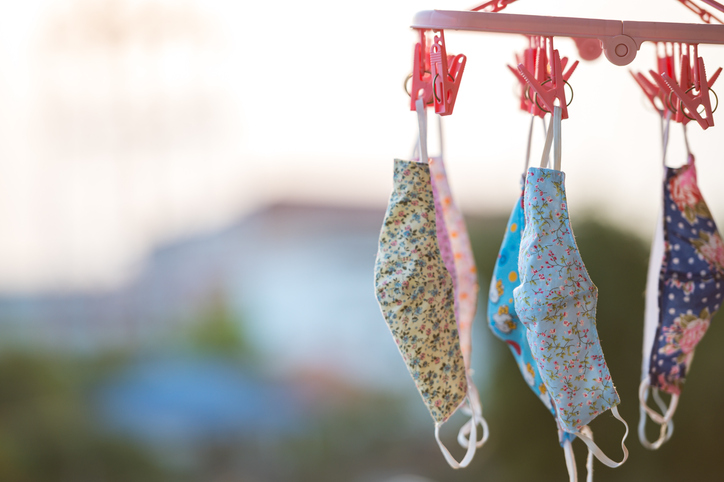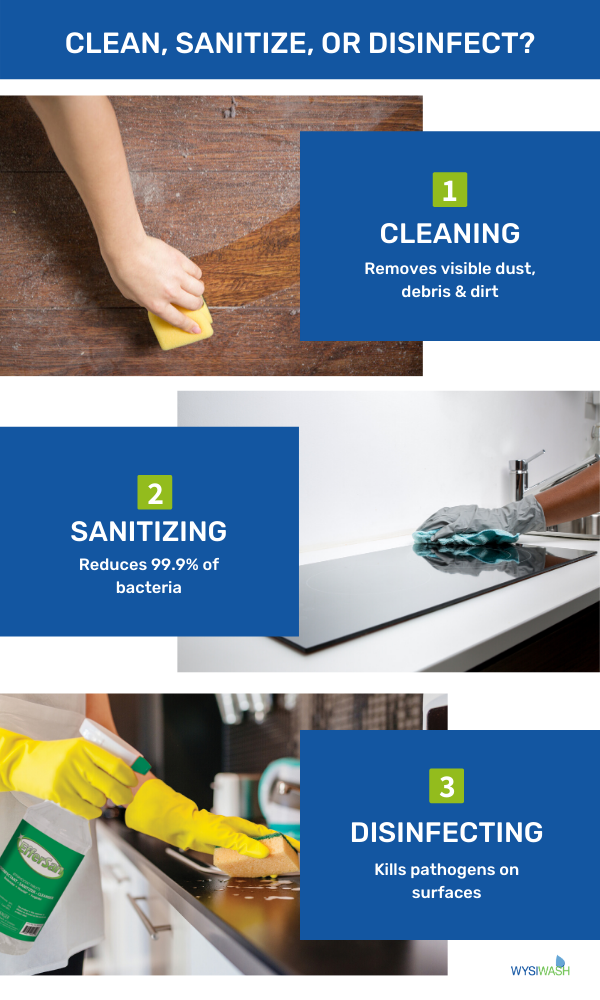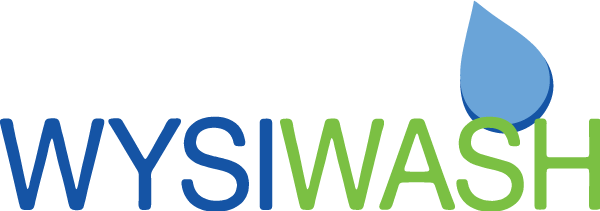The BEST Way To (Properly) Sanitize Your DIY Face Mask

Towards the beginning of April 2020, the Center For Disease Control and Prevention (CDC) recommended that anyone going outside their home should wear some form of a face mask. This sparked a wave of DIY masks and other creative face protectors…

Some people put a lot of thought into their personal protection equipment (PPE).
But not many people thought about how to sanitize and disinfect their masks once they arrived home safely.
Unlike disposable N95 masks, your cloth mask will need to be properly sanitized if you plan on reusing it.
You may have read different suggestions about how to clean your mask, like microwaving it, boiling it, or just letting it sit in the sun.
We’re sorry to tell you, but those aren’t the best ways to sanitize your mask for reuse.
What makes us qualified to tell you that?
Sanitizing and disinfecting is something that we don’t take lightly at Wysiwash. In fact, we’ve been testing cleaning solutions that kill pathogens for years. It all started when Wysiwash’s owner needed a safe and effective sanitizing solution for his family-owned dog training facility.
Wait… why does this matter for your face mask?
Well COVID-19 is a novel virus, meaning it hasn’t been identified in humans before. The virus is thought to have initially spread from an animal to a person. While many organizations test against human viruses, Wysiwash is different.
We focus on pathogens that typically begin among animals and may transfer to humans. We have successfully formulated sanitizers and disinfectants that have been tested and shown to be effective against the norovirus, RSV, H1N1, Trichophyton mentagrophytes (common cause of Athlete’s Foot), salmonella enterica, and many more.
So while our EPA-registered products can disinfect any commercial or household area, one of our first speciality markets was the animal care industry.
But with the rise of questions regarding COVID-19 and our background in sanitation, we feel qualified to give you real answers based on scientific tests and studies.
What It Means To Clean vs. Sanitize vs. Disinfect
Before we tell you about the best way to sanitize your mask, it’s important that we cover a few basics. There are significant differences between cleaning, sanitizing and disinfecting. If you’ve always used these terms interchangeably, don’t worry - you’re not alone. Let’s clear the air with these terms.
Cleaning
- Purpose: Removes visible matter such as dust, dirt, grime, or debris
- Materials Needed: Any soap or detergent and a sponge/towel
Sanitizing
- Purpose: To reduce bacteria and prevent germ spread
- Materials Needed: An EPA registered product that claims to kill 99.9% of bacteria and a sponge/towel
Disinfecting
- Purpose: To kill bacteria, viruses, and fungi
- Materials Needed: An EPA-registered disinfectant product and a sponge/towel
Note: We always recommend cleaning an object before sanitizing or disinfecting. This will make the solution more effective because it will not have to break down dirt before reducing/killing germs.

The Best Way to Sanitize Your Face Mask For Reuse
Rather than boiling masks, hand washing them, or putting them under UV rays, the best way to disinfect face masks is to put them in a washer machine with detergent and a sanitizing booster.
Here are the reasons why:
- Your washing machine will thoroughly soak your cloth mask and evenly distribute the detergent plus the sanitation booster.
- The movement and friction of your washing machine gently “scrubs” the mask, causing friction that loosens dirt and pathogens that may be within the fibers.
- As long as you put a sanitizing booster in with your mask, the washer’s hottest water setting will be effective.
- Using your washing machine is easy and keeps your mask contained in one area that will be sanitized after your run the load.
- Laundry detergent aids the booster in breaking down viruses and dirt on your face masks and clothes.
- Heat is one of the oldest ways to sanitize. The heat of the dryer will ensure that any viruses or bacteria in your laundry are gone by the time you take it out.
- The washing machine cycle is more than 5 minutes so you don’t have to worry about keeping track of the contact time.
What Laundry Detergent Should You Use?
Your laundry detergent is made from a combination of alkalies, surfactants, and catalytic enzymes. When looking at detergent ingredients, try to find one with more surfactants and enzymes than the others.
Remember that a detergent is designed to break up and remove stains and dirt. Most laundry detergents do not contain sanitatizing boosters in them.
Since conventional household detergents are not made to sanitize clothes from viruses, there really isn’t a wrong detergent to use when cleaning your mask. Just be sure to follow the instructions on your detergent and add a booster!
Effective Boosters For Sanitation
Finding an effective, yet safe booster solution can be difficult. You want to be especially careful when choosing a booster for your face mask because unlike your clothes, you’ll be placing it over your mouth!
While you can use liquid bleach, it has a lot of negatives.
Liquid bleach uses lye and other stabilizers, which is why it is so caustic and irritating. Plus, adding too much bleach is just as ineffective as adding too little.
Adding bleach to water creates a chemical reaction. This chemical reaction is most potent when done in the proper ratio, which creates a neutral pH of 6.5 - 7.5. When you add too much bleach, there is not enough water for the bleach to combine with and also changes the pH to a more alkaline/basic solution.
People think of acidity as harmful, but alkalinity is just as dangerous. When you use too much bleach alkalinity makes it a less effective disinfectant AND creates a caustic solution that will damage your clothes, washing machine, and possibly leave residue which irritates your skin.
One of the safest and most effective booster options is chlorine tablets.
You might be thinking, “Aren’t chlorine tablets for pools?”
Yes, most commercial chlorine tablets are made to disinfect pools. However, there are household chlorine cleaning tablets that are made on a smaller scale. They can be dissolved in water to use in a spray bottle to disinfect surfaces or they can be thrown into a washer machine cycle to disinfect clothes!
Chlorine Tablets vs Bleach
Bleach is a manufactured, chlorine-based liquid disinfectant. While we do not recommend bleach because of its additives and stabilizers, we do believe in using chlorine-based products to sanitize and disinfect.
Why?
Here’s some facts about chlorine, by itself:
- Chlorine is a naturally occurring element
- It has 3 different forms - gas, liquid, and solid
- Chlorine is essential for plants, animals, and humans
Chlorine is used in a variety of industries, such as farming, automotive, technology, cosmetics, and painting.
Disinfect Your Face Mask With EfferSan
Our focus at Wysiwash used to be high volume sanitation, but customers kept asking for a “pint size” Wysiwash. Hearing the pleas for a household cleaning product, we began testing prototypes. Our goal was to find a product that deodorizes, sanitizes, and kills mold as effectively as Wysiwash, without additives and stabilizers. In 2017, we finally found the perfect household sanitizing solution with EfferSan!
Here’s a breakdown about why EfferSan tablets are great for laundry sanitation:
- EfferSan is a pure sanitizer and disinfecting agent - it contains zero additives or stabilizers that could harm you or your pets
- EfferSan is bactericidal, virucidal, and fungicidal. It is EPA registered and proven to kill 99.999% of germs within 1 minute of contact!
- The concentrated tablets are designed to reduce waste and have activation control. Buying premixed cleaners means you're wasting money on water and preservatives!
- Because EfferSan is fungicidal, it can kill odor-causing mold that sticks to towels and gym clothes
- EfferSan is fabric-friendly and won’t cause bleach staining
- EfferSan tablets have a 3 year shelf life while in dry tablet form, vs liquid bleach which begins to lose efficacy after 6 months.
How to Sanitize Your Laundry With EfferSan
For best results, wash PPE in smaller loads with hot water and put them into the dryer on high. Adding too many clothes or using more water dilutes EfferSan further, making it less effective.
For HE (high efficiency) or front loading washing machines, add 1 tablet to the detergent dispenser.
For traditional top loading washing machines, add 1 EfferSan tablet to pre-filled washer. Let set 2 minutes then add laundry and detergent.
To learn more about EfferSan and how it works, visit our EfferSan guide or if you’re already sold, you can buy it in our store.
Understanding Parts Per Million (PPM) On Different Surfaces
Did you know that hard surfaces require more sanitization or disinfectant PPM than soft surfaces?
It’s true - softer surfaces, like fabrics, actually tend to dry out viruses faster because there is air moving through the weave of the fabric.
For this reason, you don’t need as much sanitation PPM for laundry, as opposed to what you need to sanitize a hard surface like a kitchen counter.
Plus there are several methods of sanitation going on with laundry all at once: EfferSan, friction, detergent, and then the heat from the dryer. All of this means you don't need as high of a concentration of EfferSan to sanitize your face masks and other PPE.
Here’s an example breakdown on how to dilute EfferSan according to the PPM needed for the object.
Disinfect Hard Surface - 1 tablet + 32 oz water
Sanitize Hard Surface - 1 tablet + 3 gallons of water
Sanitize Laundry - 1 tablet + 15-30 gallons of water
These solution directions have been tested and proven to be effective.
Frequently Asked Questions
Can you wash other clothes with your mask or other exposed PPE?
Yes you can, but keep in mind that when you add more clothes to your washer machine, you are increasing the amount of water that is going to be used to wash those clothes. Adding more water will dilute your booster agent so you will have to follow instructions on how to add more sanitizer per water amount. Doing several small loads will be more effective.
Do I need to use both EfferSan and detergent?
Yes. Detergents break up dirt and other organic matter, cleaning your face mask. The less organic matter there is, the more effective EfferSan will be.
How can I sanitize my face mask without a washing machine? Can I use EfferSan to handwash my mask?
Definitely. If you don’t have a washing machine, there are two ways to use EfferSan without a washing machine.
Handwashing Face Masks (Sanitizer Strength)
- Add 1 teaspoon of detergent to 3 gallons of hot water, agitate the clothes by rubbing them together, or stirring.
- Pour out the soapy water.
- Add 1 tablet of EfferSan to 3 gallons of potable water
- Allow to sit for 10 minutes.
- Rinse as normal.
- Hang the mask to dry or put it into your dryer.
Quick Method for Disinfecting Face Masks without a Washing Machine
- Add 1 tablet of EfferSan to 32 oz of water. Allow it to fully dissolve.
- Spray your mask in EfferSan for 5 minutes.
- Thoroughly rinse your mask with water.
- Allow the mask to dry either in the sun or with a dryer.
Does EfferSan Kill COVID-19?
Yes. EfferSan has qualified to meet the EPA Emerging Viral Pathogen Guidance for Antimicrobial Pesticides with EfferSan disinfectant against SARS-CoV-2, the novel coronavirus that causes COVID-19 (COVID-19).
EfferSan's demonstrated efficacy on a wide range of pathogens is further confirmed by its addition to the EPA's List N: Disinfectants for Use Against SARS-CoV-2. EfferSan plans to update its stamped label with Emerging Pathogens language as soon as possible.
When should I take my face mask off?
Here are some simple steps that we recommend practicing with your mask:
- Avoid touching your mask!
- As soon as you're inside your home, wash your hands first and foremost.
- After washing your hands, head to your washing machine and open it.
- Carefully take off your mask and drop it in!
- Wash your hands… Again.
Note: make sure that you immediately wash your hands BEFORE going to grab your detergent and booster to start the laundry. You touched your face mask when you took it
off so be diligent in washing your hands well!
